At the very start of 2023, I put out my thoughts on Fear & Hunger, which wound up being the most read thing in the year here. A large contributing reason to this is that popular YouTuber Super Eyepatch Wolf made a video on Fear & Hunger a few months after. Miro Haverinen’s 2018 game went from a niche title – even by RPG Maker standards – to a cult classic hit and a new face for RPG Maker overnight. So hey, remember folks: if you have a small game, you too can hope that a big Youtuber will notice you one day.
But anyway, shortly after my original review, Haverinen DM’d me a code for the sequel, which came out a few weeks before I originally wrote about it. I’ve kept it in my back pocket for a while, but as we’re heading into the new year, I thought it was finally time to go back and have some fun(ger).
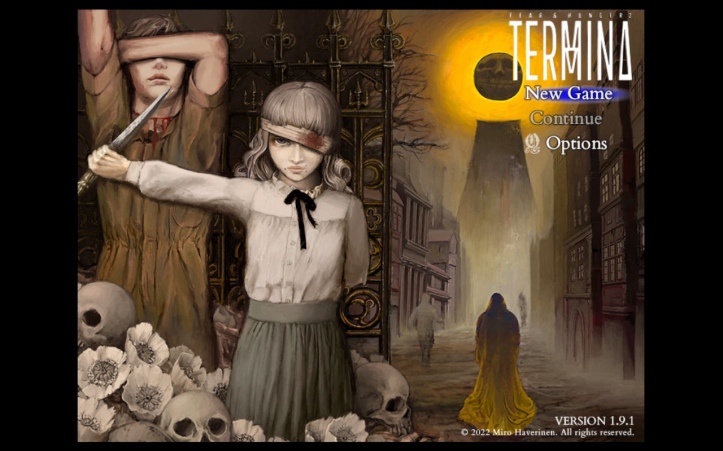
Fear & Hunger 2: Termina is the late 2022 sequel to the ascended hit game, taking place centuries down the line from the original. A group of strangers taking a train through the city of Prehevil find themselves stranded there as participants in the Festival of Termina death game, heralded by a strange collective dream. The contestants must reach the tower in the center of the city, but only one person may have a just reward and freedom… presumably. Pick your way through a cursed city, commit murder, and find an ending within all the chaos.
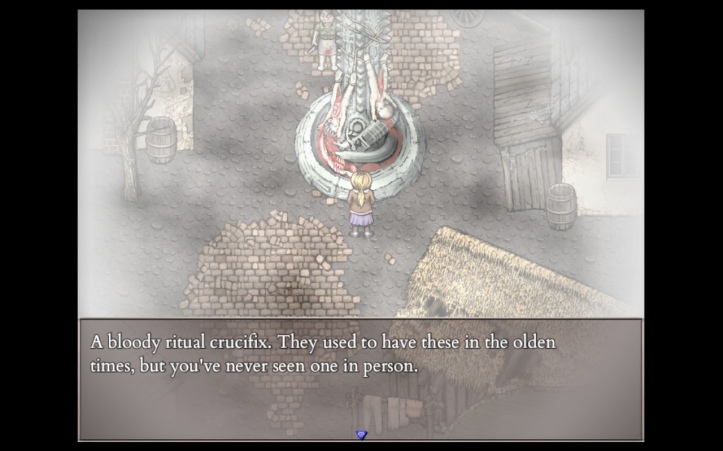
Mood-wise, Termina presents a different type of horror from its predecessor to me. The original is defined by oppression while the sequel’s defined by chaos, if that makes sense. In the original Fear & Hunger, you’re delving into a place that’s already feared, picking at its lingering mysterious aftermath and trying to forge a future out of it with the feeling that the cast is biting off more than they can chew. Termina presents a place that’s not already dead, but a place that’s in its death throes. The worst is currently happening, and while some of the main cast was already seeking Prehevil for serious reasons, they’re more or less being swept into something they did not anticipate.
Enforcing this mood is that much of the main cast is made up of relatively normal people. Sure, you got actual practiced magician O’saa and occultist Marina, but everyone else feels mundane in spite of their pasts. Like, Karin’s a journalist, but she’s not even on some Hunter S. Thompson Fear and Loathing in Prehevil type stuff, but a more ordinary investigative journalist. Though, despite being normal, the cast carries a different energy from their predecessors. The first game’s cast felt like they were trudging through a swamp to survive, while this one feels like they’re actively fighting to survive – even with each other, if you so wish.
Eight of the contestants are currently playable. Like the previous game, you can go through each character’s unique backstories to start with some extra skills and items. Special mention goes to O’saa, whose backstory is a straight up text adventure about him exploring the previous game’s dungeon.
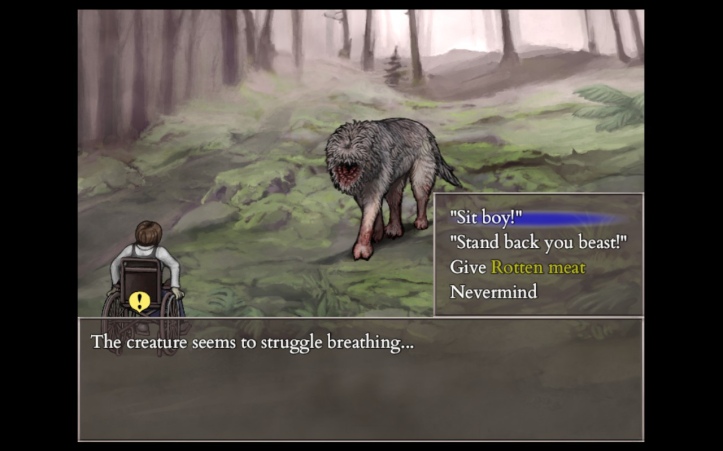
The characters all offer different playstyles befitting their nature. Marcoh was an underground boxer and has the ability to strike twice if he has no weapon equipped – and honestly, he’s the coolest fighter to use because there’s nothing more raw than beating eldritch creatures with your bare hands. Olivia is interesting in that she’s a canonically disabled character and you have to equip and unequip her wheelchair to get around – and she can straight up ram enemies if she’s riding down stairs; her being able to learn unique crafting recipes also makes her handy for survival. You don’t get access to a character’s full skillset if you aren’t playing as them, though, so characters like Olivia seem more useful if they’re leading the pack.
Termina feels more action-y compared to its predecessor, going along with the more chaotic feel of this game. There’s a lot more possible battles, and besides the premise of the Festival of Termina, you’re encouraged to fight more as instead of getting singular soul stones lying around to upgrade skills (for the most part), you need to sacrifice batches of heads of your conquered enemies to get them. With the game taking place after a fantasy World War II, guns are a prevalent element and you can just try gunning down enemies in the overworld to avoid combat altogether.
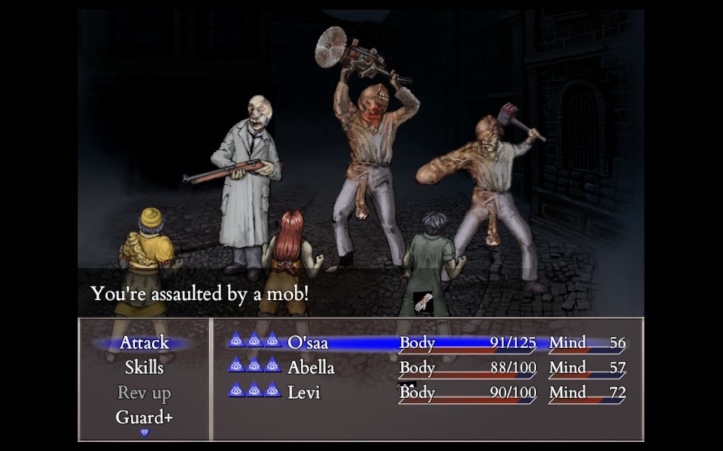
Combat is largely similar to the previous game, though it feels more refined. A new mechanic is that each character gains one rev point for every round in combat. Some magic skills require spending rev points with mind, but a big use is that you can rev up a character with banked points to hit harder or even have the normal attack hit twice. In a sense, this mechanic can enable a defensive playstyle if you actually wish to fight, encouraging you to defend a bit before striking back with a revved up character. It also acts as a way to balance out spells without demanding you to spend an unreasonable amount of mind.
While there’s a stronger focus on action, the fusion of RPG mechanics with survival horror mechanics that defined the previous game is still very much present. Healing resources are tough to manage, starvation is still a threat, and people still regularly take mental damage while walking around. The nature of the Festival of Termina presents a new wrinkle this time, though. It’s nice to have extra party members to deal with the horrors, and sure, you’ll need to juggle meager resources to keep everyone alive. But consider: what if you want to get that victory royale? Your character can attack your fellow contestants to play along with the festival’s rules. Killing another contestant grants you their soul, allowing your character to learn their skills, including the ones that they don’t have as party members. Sure, having a squad of four party members sounds good… but you can also have a character with the powers of four or more instead, if you so wish. Dealing with the RNG of item drops ain’t as much of a problem if you’re riding solo, after all.
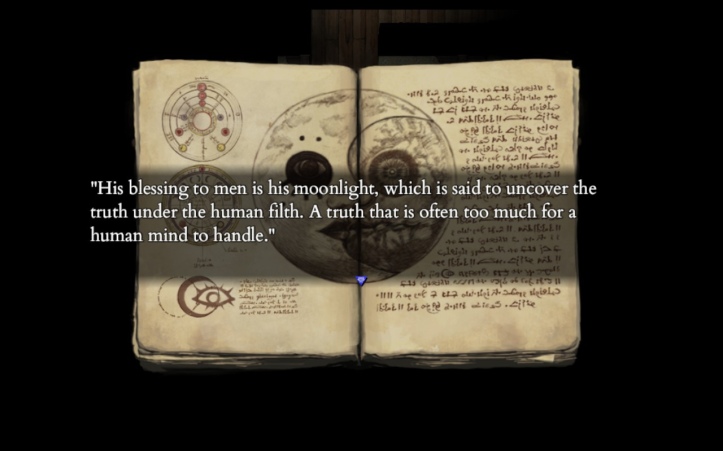
Besides, if you’re actually aiming for an ending where your character stands above in the death game, it’s better to kill everyone before they become moonscorched when you have the chance.
Around town, people have become distorted body horrors in the rays of the moon. At best, ordinary citizens are tearing at their own skin in despair, and at worst, they’re rampaging beasts that barely look human. As it turns out, that also applies to the contestants. At certain points, a contestant will become moonscorched, becoming horrible beasts with symbolic forms that are almost always kill on sight.
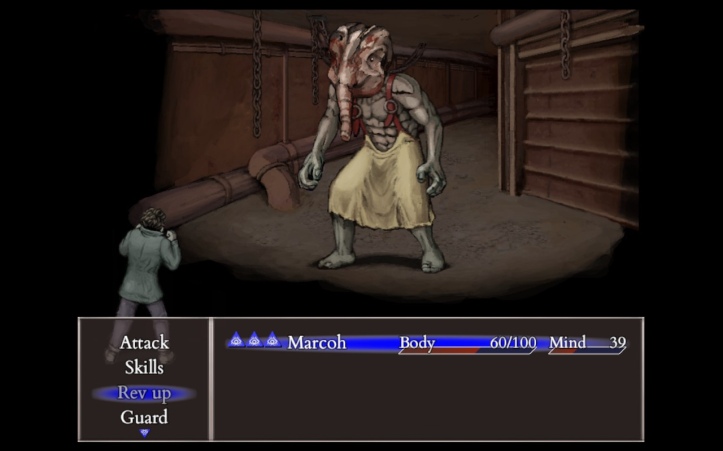
I did not realize that aspect of the game until I met Chaugnar. In a playthrough where I played Marcoh, I went northwest to these underground tunnels to look for keys. I started hearing loud banging, and the moment I got a generator running, this elephant-headed creature in overalls burst through a wall. This creature ran at me and tore Marcoh apart the first time. On the second go around, Marcoh got a lucky critical hit that downed her. But in doing so, I gained a player soul, and then it hit me why Chaugnar’s overalls looked familiar.
This encouraged me to start the file over and immediately go to the tunnels to see if anything was different, and lo and behold, Abella was alive and normal. It’s also here that the NPC contestant Tanaka gets murdered by a clown. I have not figured out how to save his life yet (mainly because I prefer playing blind), but I’m sure there’s an answer out there.
That takes me into another important aspect of Termina: its scheduling. NPCs are out there navigating Prehevil on their own throughout the three days of the festival, pursuing their own goals until the moon takes them. Karin walks on the east side of Prehevil on the first day and will be taking pictures in west Prehevil on the second, Abella will become moonscorched if not recruited immediately, Marcoh will start shit with Pav at the entrance of the town on the second day, etc.
Navigating the schedule will be difficult because it does not operate on real time, but time advances whenever you rest and save. If you’re a compulsive saver, you are not safe, because besides losing out on potential party members, you’re hastening your character’s own moon scorching. There are a few ways to save without advancing time, but as you might expect, those opportunities are limited.
Your early playthroughs will likely be defined by you learning the rules of the game, the schedules of the characters and the specific dangers to account for. For later playthroughs, you’ll ideally be trying to get as much done as possible between saves. By making saves so valuable, there’s so much stress added to the RPG experience. Like, do I dare explore this place and risk wasting the past half hour of real time, or do I save and risk in-game time? It’s stressful, but it’s very engaging.
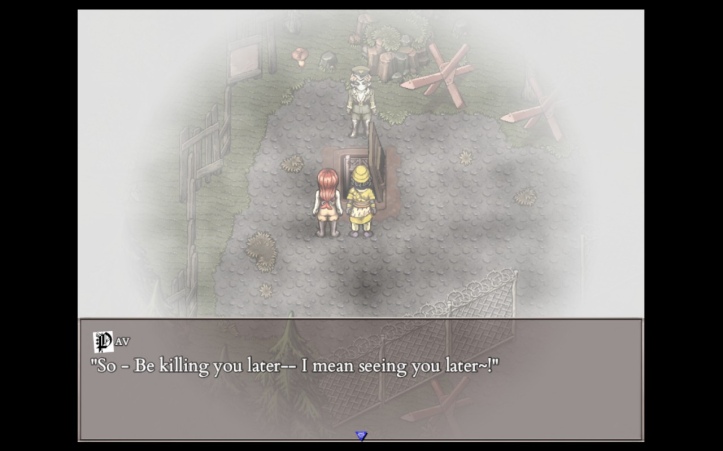
Going back to Pav, he presents something that I feel might bother people. While the premise creates the expectation that you’ll be fighting other contestants, they don’t really pick fights with you – when they aren’t moonscorched, at least. There’s only two people that truly bear ill will: Pav and Caligura – who I only met once and that was him attempting to sexually assault Marina during my brief attempt at playing as her. The lack of real hostility from others initially felt weird to me, given how bleak the setting is.
(As a quick aside, I do think the presence of rape is better utilized than the original game? You pretty much kill Caligura before he does something and the implied assault by that clown if you lose to him is presented in an abstract way, which is way better than the explicit onscreen assault by the Fear and Hunger guards.)
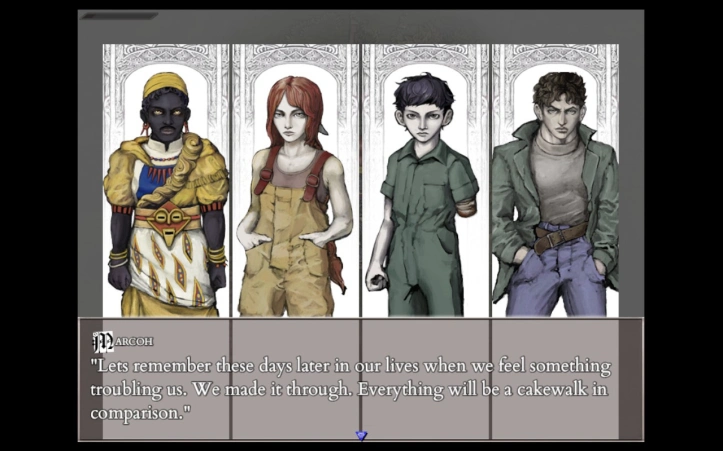
That said, the more I thought about it, I feel that the contestants not being hostile toward you reflects a humanistic element in the game. While there are fucked up gods and mundane wars in the Fear & Hunger world, goodness still exists in it. Some of the early moonscorched enemies could waver in their assaults if you talk to them, while the moonscorched version of Henryk could actually be negotiated with, showing that it’s possible to not let the homicidal rage of Rher take you over. There’s stuff like Marcoh going out of his way to get a new wheelchair for Olivia on any route besides her own, and Abella trying to comfort Levi when he was uncomfortable sharing about things in Prehevil during some party talks.
The ultimate example of this is the presence of the God of Fear and Hunger. This god was the little girl in the previous game, who ascends to godhood in one of the endings, becoming a new god that has humanity’s best interests at heart… in a screwed up sense. She brought on an age of suffering to the world between this game and the previous one, but it was all done in the belief that suffering builds character. It’s cynical, but it’s cynicism born out of love – especially since this ending route is achieved from rescuing and caring for the girl until the end.
Tellingly, the reward you get from drawing the God of Fear and Hunger’s sigil on a circle is a free save point. While it continues to facilitate your suffering, it offers what may be a much needed reprieve in a cruel world. Especially in MasoX-S/M Mode.
MasoX-S/M Mode is the game’s hardest difficulty where you’re locked into the night of the final day, so you can’t go to sleep to save or upgrade skills. Everyone is moonscorched, and you might join them too, because now, the rays of the moon will actually mutate you if you’re outside for too long. The moon is Rher’s throne, and we must rejoice.
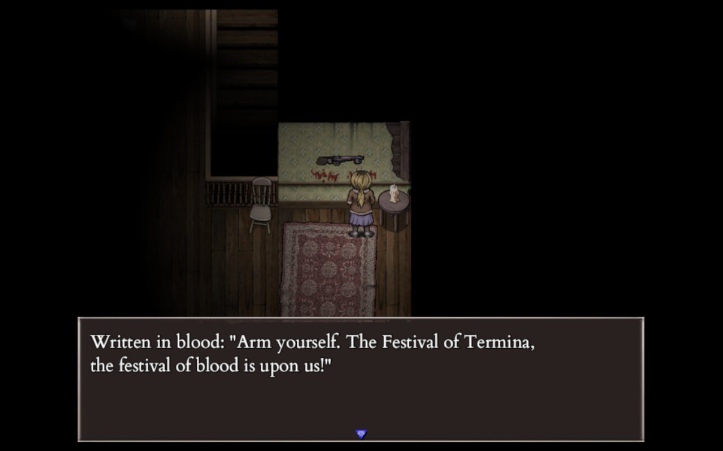
While play sessions of Termina may end up being shorter than other RPGs, it’s a dense game that invites a lot of replays, even if you have a successful playthrough. There are those different characters to play as, different endings, lots of side stuff to poke into, lots of possible character conversations and interactions depending on party makeup and time, etc. In line with the ethos of the God of Fear and Hunger, if you can put up with the trials that Prehevil throws at you, you’ll be satisfied in reaching the other side.
Fear & Hunger 2: Termina is an excellent game if you’re picking up what it’s putting down. If you want to play an evil RPG, this is one to check out. The game is still getting updates and is apparently due to have a big one soon, and if I had any wishes for the game, it’d be for an equivalent to Dungeon Nights mode. It’d go so fucking hard.
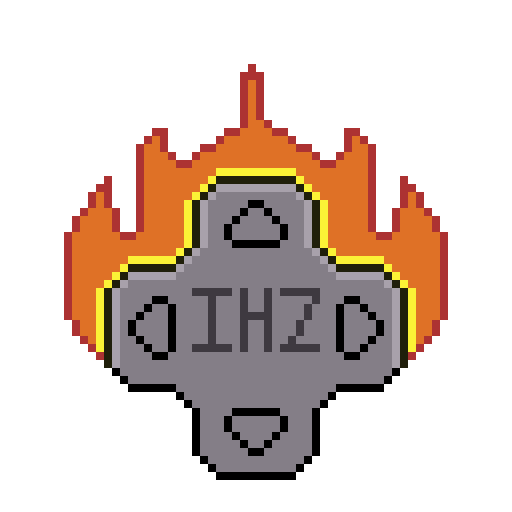
[…] Fear & Hunger 2: Termina | Indie Hell Zone Dari spends some time with a horror RPG follow-up that goes hard (content notification: brief discussion of sexual assault). […]
LikeLike